| Manyana Rock Paintings | |
|---|---|
 Four yellow animals | |
| Location | Kweneng District, Botswana |
| Coordinates | 24°45′52″S 25°35′28″E / 24.76444°S 25.59111°E |
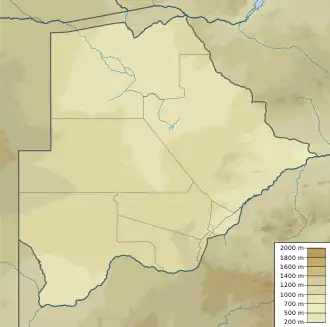 Manyana Rock Paintings | |
The Manyana Rock Paintings are a collection of rock art and caves located at the Kolobeng hills, neighbouring Manyana, Southern District, Botswana. It is believed that the artworks were made by the Khoikhoi or the San people between 1100 AD and 1700 AD.[1] The paintings are found on five cliff areas around the rocky hill.[2] Today, the site is fenced and protected as a National Monument.[3][4]
Geography
The paintings cover 5 separate rock surfaces, along approximately 750 meters of the base of the Kolobeng hills, 1.2 km above sea level. The site is close to the village of Manyana, Southern district but lies within the borders of the Kweneng district.
Artworks
The paintings include designs of mammals, plants and abstract shapes. All of the mammals were portrayed sideways with only two legs, except human figures, most of which seem to face forward.[2] It is believed that the paintings were created by witch doctors as part of religious activities.[5] These rituals also incorporate dancing as an attempt to connect with the spirits of ancestors.[6] The ink used for the paintings were created by mixing soft rocks like bauxite and animal body fluids like blood.
Due to natural weathering, a lot of the paintings have faded. As a result, the number of tourists visiting the site have declined.[7][8][4][9]
Archaeology
Rock paintings are scarce in southeast Botswana and the Manyana Rock Paintings are the only ones that have been excavated. Artifacts recovered from excavations suggest that the earliest occupation of this area took place between the 1st century and the 8th century, during the Later Stone Age. The Iron Age pottery uncovered suggests that the locals made their first contact with Iron Age herders between the 10th century and the 13th century.
Excavations uncovered more than 7000 Later Stone Age artifacts, more than 95% are debitage. The remaining 5% is made up of scrapers, grindstones, hammerstones and crescents. Other unearthed items include quartz slivers, specularite, bones, glass, Iron Age potshreds and 19th century porcelain.[2]
Mmasechele Cave

In 1852, a group of four Batswana tribes, led by Sechele I, Kgosi (chief) of the Bakwena tribe, fought against the Boers in the Battle of Dimawe. There was an attempt to refuge and relocate the women and children in the area. The third wife of Sechele fled and hid in the Mmasechele cave.[10] There are no historical records regarding how long the women took shelter for but she managed to survive until the war ended in 1853.[11][12]
Gallery
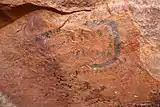 A black rectangular enclosure with rows of dots
A black rectangular enclosure with rows of dots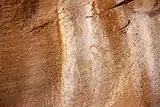 Four yellow giraffes, situated 2.4 to 3.0 meters above the ground. These are the highest and clearest of the Manyana paintings.
Four yellow giraffes, situated 2.4 to 3.0 meters above the ground. These are the highest and clearest of the Manyana paintings. A red gemsbok
A red gemsbok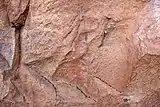 A black, medicinal herb
A black, medicinal herb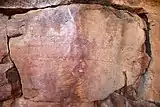 Three men carrying a prey on their back
Three men carrying a prey on their back One giraffe and three kudus. The giraffe is situated at the top center
One giraffe and three kudus. The giraffe is situated at the top center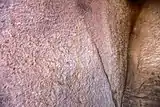 A man
A man A rhinoceros facing the left
A rhinoceros facing the left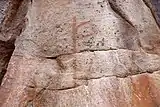 What looks like the letter "p" is believed to be the symbol of venomous snakes
What looks like the letter "p" is believed to be the symbol of venomous snakes Two men, a woman (right) and a kudu (bottom left)
Two men, a woman (right) and a kudu (bottom left) A zebra standing upright
A zebra standing upright
References
- ↑ L. H. Robbins (1986). "Recent Archaeological Research in Southeastern Botswana: The Thamaga Site". Botswana Notes and Records. 18: 1–13. JSTOR 40979755.
- 1 2 3 L.H. ROBBINS (1985). "The Manyana Rock Painting Site". Botswana Notes and Records. Botswana Notes and Record. 17: 1–14. JSTOR 40979730.
- ↑ "Manyana". Botswana Tourism. Retrieved 12 August 2019.
- 1 2 Thaband Metsimabe (6 October 2016). "Manyana's awe-inspiring heritage sites". Botswana Daily News. Retrieved 12 August 2019.
- ↑ "Manyana Rock Paintings Shelter". Retrieved 12 August 2019.
- ↑ James Raymond Denbow; Phenyo C. Thebe (2006). "4 Art and Architecture" (PDF). In Toyin Falola (ed.). Culture and Customs of Botswana. Greenwood Press. Retrieved 12 August 2019.
- ↑ "National Museum in promoting protection of rock paintings". Sunday Standard. 15 May 2012. Retrieved 12 August 2019.
- ↑ Phemelo Ramasu (26 February 2016). "Manyana's awe-inspiring heritage sites". Botswana Guardian. Retrieved 12 August 2019.
- ↑ Dewah, Jane Thato (December 2014). Make Gaborone a Stop and not a Stop-Over: a Heritage and Cultural Tourism Destination (PDF) (Thesis). University of Pretoria. pp. 78–80. Retrieved 14 August 2019.
- ↑ Legodimo, Chippa (22 June 2012). "How the Battle of Dimawe shaped Botswana". Mmegi. Archived from the original on 4 March 2016. Retrieved 12 August 2019.
- ↑ Legodimo, Chippa (13 January 2012). "Manyana village has a rich history". Mmegi. Retrieved 12 August 2019.
- ↑ Dewah, Jane Thato (December 2014). Make Gaborone a Stop and not a Stop-Over: a Heritage and Cultural Tourism Destination (PDF) (Thesis). University of Pretoria. pp. 82–83. Retrieved 14 August 2019.
Further reading
- Campbell, Alec C. Sites of historic and natural interest in and around Gaborone. Gaborone, Botswana: The National Museum and Art Gallery.
- L.H. ROBBINS (1985). "The Manyana Rock Painting Site". Botswana Notes and Records. Botswana Society. 17: 1–14. JSTOR 40979730. This journal covers all of the painting site's basic information.